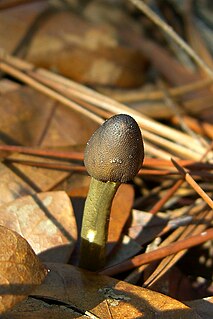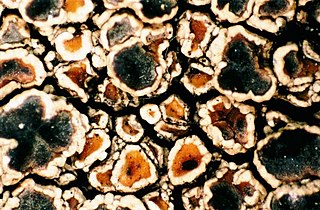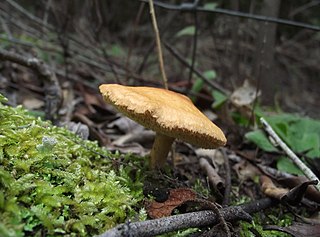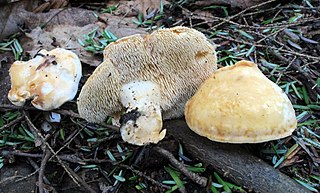
Volvariella is a genus of mushrooms with deep salmon pink gills and spore prints.

A basidiospore is a reproductive spore produced by Basidiomycete fungi, a grouping that includes mushrooms, shelf fungi, rusts, and smuts. Basidiospores typically each contain one haploid nucleus that is the product of meiosis, and they are produced by specialized fungal cells called basidia. Typically, four basidiospores develop on appendages from each basidium, out of these 2 are of one strain and other 2 of its opposite strain. In gills under a cap of one common species, there exist millions of basidia. Some gilled mushrooms in the order Agaricales have the ability to release billions of spores. The puffball fungus Calvatia gigantea has been calculated to produce about five trillion basidiospores. Most basidiospores are forcibly discharged, and are thus considered ballistospores. These spores serve as the main air dispersal units for the fungi. The spores are released during periods of high humidity and generally have a night-time or pre-dawn peak concentration in the atmosphere.

The Hypocreales are an order of fungi within the class Sordariomycetes. In 2008, it was estimated that it contained some 237 genera, and 2647 species in seven families. Since then, a considerable number of further taxa have been identified, including an additional family, the Stachybotryaceae. According to the Catalog of Life, As of April 2021 the Hypocreales contains 6 families, 137 genera, and 1411 species.

Hydnum repandum, commonly known as the sweet tooth, wood hedgehog or hedgehog mushroom, is a basidiomycete fungus of the family Hydnaceae. First described by Carl Linnaeus in 1753, it is the type species of the genus Hydnum. The fungus produces fruit bodies (mushrooms) that are characterized by their spore-bearing structures—in the form of spines rather than gills—which hang down from the underside of the cap. The cap is dry, colored yellow to light orange to brown, and often develops an irregular shape, especially when it has grown closely crowded with adjacent fruit bodies. The mushroom tissue is white with a pleasant odor and a spicy or bitter taste. All parts of the mushroom stain orange with age or when bruised.

Hydnum is a genus of fungi in the family Hydnaceae. They are notable for their unusual spore-bearing structures of teeth rather than gills. The best known are the edible species Hydnum repandum and H. rufescens. The word is derived from (h)udnon/ύδνον, an Ancient Greek word for truffle. The white or buff Hydnum repandum has a spore scatterer of still another shape. The smooth cap grows as wide as 8 inches across. The stem is off-center and is less than 2 inches long. Hydnum has many brittle, white teeth from which the spores drop. The mushrooms of the Hydnum group grow both on ground and on wood. Some species have teeth which hang from ascending branches, while other species have teeth which project downwards from the undersurfaces of dead wood. Most Hydnum are safe to eat.

Hydnellum is a genus of tooth fungi in the family Bankeraceae. Widely distributed in the Northern Hemisphere, the genus contains around 40 species. The fruitbodies of its members grow by slowly enveloping nearby bits of grass and vegetation. There is great variability in the form of Hydnellum fruitbodies, which are greatly influenced by environmental conditions such as rainfall and humidity, drying winds, and temperature. They are too tough and woody to eat comfortably. Several species have become the focus of increasing conservation concern following widespread declines in abundance.

Megasporaceae are a family of fungi belonging to the order Pertusariales. Taxa are lichenized with green algae, and grow on rocks, often in maritime climates close to fresh water. Phylogenetic analysis has shown that this family is related to the Pertusariaceae, another family of lichens. The genus Aspicilia was moved here from the Hymeneliaceae.

The Hydnaceae are a family of fungi in the order Cantharellales. Originally the family encompassed all species of fungi that produced basidiocarps having a hymenium consisting of slender, downward-hanging tapering extensions referred to as "spines" or "teeth", whether they were related or not. This artificial but often useful grouping is now more generally called the hydnoid or tooth fungi. In the strict, modern sense, the Hydnaceae are limited to the genus Hydnum and related genera, with basidiocarps having a toothed or poroid hymenium. Species in the family are ectomycorrhizal, forming a mutually beneficial relationship with the roots of trees and other plants. Hydnum repandum is an edible species, commercially collected in some countries and often marketed under the French name pied de mouton.

The Sphaerophoraceae are a family of lichenized fungi in the order Lecanorales. Species of this family have a widespread distribution, especially in southern temperate regions. Sphaerophoraceae was circumscribed by mycologist Elias Magnus Fries in 1831.

Phellodon is a genus of tooth fungi in the family Bankeraceae. Species have small- to medium-sized fruitbodies with white spines on the underside from which spores are released. All Phellodon have a short stalk or stipe, and so the genus falls into the group known as "stipitate hydnoid fungi". The tough and leathery flesh usually has a pleasant, fragrant odor, and develops a cork-like texture when dry. Neighboring fruitbodies can fuse together, sometimes producing large mats of joined caps. Phellodon species produce a white spore print, while the individual spores are roughly spherical to ellipsoid in shape, with spiny surfaces.

The Physciaceae are a family of mostly lichen-forming fungi belonging to the class Lecanoromycetes in the division Ascomycota. Many members of this family are known as shadow lichens. A 2016 estimate placed 19 genera and 601 species in the family.

The Ostropales are an order of fungi in the class Lecanoromycetes. The order was circumscribed by Swedish botanist John Axel Nannfeldt in 1932. The order contains 4 families and 46 genera, including 6 genera of uncertain familial placement.
Hydnellum nigellum is a tooth fungus in the family Bankeraceae. Found in Nova Scotia, Canada, where it grows under spruce, it was described as new to science in 1964 by Canadian mycologist Kenneth A. Harrison. The fruitbodies of this fungus are small, measuring 3–6 cm (1.2–2.4 in) in diameter, and black.

Sarcodon rimosus, commonly known as the cracked hydnum, is a species of tooth fungus in the family Bankeraceae. Found in the Pacific Northwest region of North America, it was described as new to science in 1964 by mycologist Kenneth A. Harrison, who initially called it Hydnum rimosum. He transferred it to the genus Sarcodon in 1984. Fruit bodies of S. rimosum have convex to somewhat depressed caps that are 4–12 cm (1.6–4.7 in) in diameter. The surface becomes scaly in age, often developing conspicuous cracks and fissures. It is brown with violet tints. The flesh lacks any significant taste and odor. Underneath the cap cuticle, the flesh turns a bluish-green color when tested with a solution of potassium hydroxide. The brownish-pinks spines on the cap underside are typically 2.5–7 mm long, extending decurrently on the stipe. Spores are roughly spherical with fine warts on the surface, and measure 5–6.5 by 4.5–5 µm. The hyphae do not have clamp connections.

Sarcodon calvatus is a species of tooth fungus in the family Bankeraceae. It was described as new to science in 1964 by mycologist Kenneth A. Harrison, who initially called it Hydnum calvatum. He transferred it to the genus Sarcodon in 1984. It is found in North America.

Hydnum albomagnum, commonly known as the giant hedgehog, is a species of fungus in the family Hydnaceae native to North and Central America.

Hydnum ovoideisporum is a species of fungus in the family Hydnaceae native to the southern Europe.
Hydnum vesterholtii is a species of fungus in the family Hydnaceae native to the southern and Central Europe and southwestern China.
Hydnum crocidens is a species of fungus in the family Hydnaceae native to Australia. It was described in 1890 by Mordecai Cubitt Cooke from material collected around Port Phillip Bay. Genetic analysis shows it to be closely related to a lineage containing H. rufescens and its close relatives.

Hydnum albidum, commonly known as the white hedgehog, is an edible species of fungus in the family Hydnaceae native to North America.
















